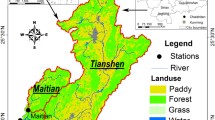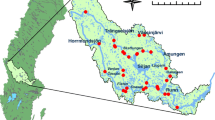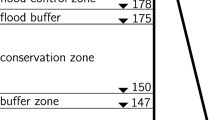Abstract
Understanding the behavior of reservoirs with flow regularization formed by hydroelectric power plants is essential for assessing water availability. The operationalization of reservoirs can be influenced both by climatic characteristics and by the consequences resulting from human actions in the basin. The objective of this study was to evaluate the existing relationships between the inflows and outflows of a reservoir, as well as with the conventional streamflow gauge stations downstream of the dam. Also evaluated were trends in the behavior of minimum, average and maximum flows, in the post-operation period, considering the characteristics of rainfall and irrigation in the region. The results indicated that reservoir operationalization is strongly related to the behavior of inflows. Moreover, a reduction was also verified in all the variables analyzed related to inflows and outflows, as well as in the stations downstream of the dam, except for the maximum flow in the station farthest from the reservoir, which showed a stationary behavior. The reductions in the flows may be related to the almost three-fold increase in the area irrigated by the center pivot in the basin; however, the same cannot be said in relation to the annual rainfall regime of the region, since it showed a stationary behavior for most of the stations evaluated. The work demonstrates the importance of trend analysis of flows over the years in order to identify possible factors responsible for their variability and assist in decision making regarding measures for the recovery and preservation of water resources.






Similar content being viewed by others
Data Availability
Agência Nacional de Águas (ANA).
References
Abeysingha NS, Singh M, Sehgal VK, Khanna M, Pathak H (2016) Analysis of trends in streamflow and its linkages with rainfall and anthropogenic factors in Gomti River basin of North India. Theor Appl Climatol 123:785–799. https://doi.org/10.1007/s00704-015-1390-5
Agência Nacional de Águas – ANA (2016) Resolução 934 de 15 de agosto de 2016. Autorizar, até 31 de outubro de 2016, a redução da descarga mínima do reservatório da UHE Queimado, no rio Preto. Brasília.
Agência Nacional de Águas e Saneamento Básico – ANA (2021) Atlas Irrigação: Uso da água na agricultura irrigada. 2ª ed. Brasília
Agência Reguladora de Água, Energia e Saneamento do Distrito Federal – ADASA. Cadastro de Outorga e Registros de Uso de Recursos Hídricos no DF – SIRH/DF. Available at: < https://gis.adasa.df.gov.br/portal/apps/webappviewer/index.html?id=716687c019ec41aa892c8845b517da24. Accessed 21 June 2021
Asitatikie AN, Nigussie ED (2020) Modeling on naturalization of inflow and outflow nutrients sources of Blue Nile River at the Lake Tana in Basaltic Plateau of Ethiopia. Model Earth Syst Environ 7:2283–2295. https://doi.org/10.1007/s40808-020-00972-x
Bozzoni PL, Mello Junior AV (2020) Previsões de precipitação de modelos atmosféricos como subsídio à operação de sistemas de reservatório. Rev Bras de Meteorol 35:99–109. https://doi.org/10.1590/0102-778635103
Chang L-C, Chang F-J (2001) Intelligent control for modelling of real-time reservoir operation. Hydrol Process 15:1621–1634. https://doi.org/10.1002/hyp.226
Dubey SK, Sharma D, Babel MS, Mundetia N (2020) Application of hydrological model for assessment of water security using multi-model ensemble of CORDEX-South Asia experiments in a semi-arid river basin of India. Ecol Eng 143:105641. https://doi.org/10.1016/j.ecoleng.2019.105641
Ferrari AL (2012) Variabilidade e tendência da temperatura e pluviosidade nos municípios de Pirassununga, Rio Claro, São Carlos e São Simão (SP): Estudo sobre mudança climática de curto prazo em escala local. Tese. Universidade de São Paulo-USP, São Carlos/SP
Hamed KH, Rao R (1998) A modified Mann-Kendall trend test for auto-correlated data. J Hydrol 204:182–196. https://doi.org/10.1016/S0022-1694(97)00125-X
Helsel DR, Hirsch RM (2002) Statistical methods in water resources. US Geological Survey
Helsel DR, Hirsch RM, Ryberg KR, Archfield SA, Gilroy EJ(2020) Statistical methods in water resources: US Geological Survey Techniques and Methods, book 4, chapter A3. https://doi.org/10.3133/tm4a3
Hirsch RM, Slack RJ, Smith R (1982) Techniques of trend analysis for monthly water quality data. Water Resour Res 18:107–121. https://doi.org/10.1029/WR018i001p00107
Kwarteng EA, Gyamfi C, Anyemedu FOK, Adjei KA, Anornu GK (2020) Coupling SWAT and bathymetric data in modelling reservoir catchment hydrology. Spat Inf Res 29(1):55–69. https://doi.org/10.1007/s41324-020-00337-7
Kendall MG (1975) Rank Correlation Methods. Charles Griffin, London
Mann HB (1945) Nonparametric tests against trend. Econometrica 13:245–259
Machado NDS, Netto OMC Análise econômica aplicada à decisão sobre alocação de água entre os usos irrigação e produção de energia elétrica: o caso da bacia do rio Preto(2010) (. Ver Bras Recur Hídr 15:105–119. https://doi.org/10.21168/rbrh.v15n4.p105-119
de la Molina ZB C (2016) Avaliação da acurácia do modelo de simulação a usinas individualizadas baseadas no pós-operativo. Dissertação. Universidade Estadual de Campinas, Campinas/SP
Neeti N, Eastman JR (2011) A Contextual Mann-Kendall Approach for the Assessment of Trend Significance in Image Time Series. Trans GIS 15:599–611. https://doi.org/10.1111/j.1467-9671.2011.01280.x
Nkuna TR, Odiyo JO (2011) Filling of missing rainfall data in Luvuvhu River Catchment using artificial neural networks. Phys Chem Earth 36:830–835. https://doi.org/10.1016/j.pce.2011.07.041
Nourani V, Rouzegari N, Molajou A, Baghanam AH (2020) An integrated simulation-optimization framework to optimize the reservoir operation adapted to climate change scenarios. J Hydrol 587. doi: https://doi.org/10.1016/j.jhydrol.2020.125018
Operador Nacional do Sistema Elétrico – ONS (2020) Manual de procedimentos de operação: Módulo 5 – Submódulo 5.12. Available at: http://www.ons.org.br/%2FMPO%2FDocumento%20Normativo%2F3.%20Instru%C3%A7%C3%B5es%20de%20Opera%C3%A7%C3%A3o%20-%20SM%205.12%2F3.6.%20Opera%C3%A7%C3%A3o%20de%20Reservat%C3%B3rios%2FIO-OR.SF.SFR_Rev.23.pdf Accessed 18 May 2021
Passaia OA, Paiva RCD (2019) Análise exploratória do comportamento de reservatórios do sistema interligado nacional. XXIII Simpósio Brasileiro de Recursos Hídricos. Foz do Iguaçu
Pereira G, Cardozo F, da S, Negreiros, de Zanin AB, Costa GD, JC da, Lima, Rufino TER, PR, Ramos R de(2018) C Análise da variabilidade da precipitação para o estado de Minas Gerais (1981–2017). RBClima. doi: https://doi.org/10.5380/abclima.v1i0.61028
Rodrigues LN, Sano EE, Steenhuis TS, Passo DP (2012) Estimation of small reservoir storage capacities with remote sensing in the Brazilian Savannah region. Water Resour Manage 26:873–882. doi: https://doi.org/10.1007/s11269-011-9941-8
Salviano MF, Groppo JD, Pellegrino GQ (2016) Análise de Tendências em Dados de Precipitação e Temperatura no Brasil. Rev Bras Meteorol 31:64–73. https://doi.org/10.1590/0102-778620150003
Schaefli B (2015) Projecting hydropower production under future climates: a guide for decision-makers and modelers to interpret and design climate change impact assessments. Wiley Interdiscip Ver: Water 2:271–289. https://doi.org/10.1002/wat2.1083
Silva FB, Almeida LT de, Vieira EO de, Silva DD da, Maciel IP, Parma Júnior F(2020) Pluviometric and fluviometric trends in association with future projections in areas of conflict for water use. J Environ Manage 271. https://doi.org/10.1016/j.jenvman.2020.110991
da Silva RM, Santos CAG, Moreira M, Corte-Real J, Silva VCL, Medeiros IC (2015) Rainfall and river flow trends using Mann–Kendall and Sen’s slope estimator statistical tests in the Cobres River basin. Nat Hazards 77:1205–1221. https://doi.org/10.1007/s11069-015-1644-7
Sen PK (1968) Estimates of the regression coefficient based on Kendall’s Tau. J Am Stat Assoc 63:1379–1389
Spalding-Fecher R, Chapman A, Yamba F, Walimwipi H, Kling H, Tembo B, Nyambe I, Cuamba B (2014) The vulnerability of hydropower production in the Zambezi River Basin to the impacts of climate change and irrigation development. Mitig Adapt Strateg Glob Chang 19:1–22. https://doi.org/10.1007/s11027-014-9619-7
Setti AA, Lima JEFW, Chaves AG, de Pereira M, de C I (2000) Introdução ao gerenciamento de recursos hídricos. Agência Nacional de Energia Elétrica, Superintendência de Estudos e Informações Hidrológicas. 2ª Ed. Brasília.
Tucci CEM, Braga B (2003) Clima e Recursos Hídricos no Brasil. ABRH, Porto Alegre
World Meteorological Organization (1975) Drought and agriculture. WMO Tech. Note 138, Publ. WMO-392, Geneva, Switzerland
World Meteorological Organization (1988) Analyzing long timeseries of hydrological data with respect to climate variability. Wcap-3. WMO/TD 224
Wu J, Liu Z, Yao H, Chen X, Chen X, Zheng Y, He Y (2018) Impacts of reservoir operations on multi-scale correlations between hydrological drought and meteorological drought. J Hydrol 563:726–736. https://doi.org/10.1016/j.jhydrol.2018.06.053
Yue S, Pilon P, Cavadias G (2002) Power of the Mann-Kendall and Spearman’s rho tests for detecting monotonic trends in hydrological series. J Hydrol 259:254–271. https://doi.org/10.1016/S0022-1694(01)00594-7
Yue S, Pilon P, Cavadias G (2002) Power of the Mann-Kendall and Spearman’s rho tests for detecting monotonic trends in hydrological series. J Hydrol 259:254‒271. https://doi.org/10.1016/S0022-1694(01)00594-7
Acknowledgements
The authors would like to thank the Department of Agricultural Engineering (DEA) and the Universidade Federal de Viçosa for supporting this research.
Funding
This study was financed in part by the Coordenação de Aperfeiçoamento de Pessoal de Nível Superior - Brasil (CAPES) – Finance Code: 001 and by the Conselho Nacional de Desenvolvimento Científico e Tecnológico (CNPq).
Author information
Authors and Affiliations
Contributions
Tarcila Neves Generoso, Demetrius David da Silva, Ricardo Santos Silva Amorim, Lineu Neiva Rodrigues and Laura Thebit de Almeida participated in the creation, design, material preparation, data collection and analysis.
Corresponding author
Ethics declarations
Ethical Approval
Not applicable.
Consent to Participate
The authors have consent to participate in the publication process.
Consent to Publish
The authors have agreed to publish this manuscript.
Competing Interests
The authors declare the following financial interests/personal relationships which may be considered as potential competing interests: Demetrius David da Silva reports that financial support was provided by Coordenação de Aperfeiçoamento de Pessoal de Nível Superior - Brasil (CAPES) and by the Conselho Nacional de Desenvolvimento Científico e Tecnológico (CNPq).
Additional information
Publisher’s Note
Springer Nature remains neutral with regard to jurisdictional claims in published maps and institutional affiliations.
Rights and permissions
Springer Nature or its licensor holds exclusive rights to this article under a publishing agreement with the author(s) or other rightsholder(s); author self-archiving of the accepted manuscript version of this article is solely governed by the terms of such publishing agreement and applicable law.
About this article
Cite this article
Generoso, T.N., da Silva, D.D., Rodrigues, L.N. et al. Analysis of Flow Behavior as Influenced by Reservoir with Flow Regularization. Water Resour Manage 36, 4721–4737 (2022). https://doi.org/10.1007/s11269-022-03274-2
Received:
Accepted:
Published:
Issue Date:
DOI: https://doi.org/10.1007/s11269-022-03274-2




